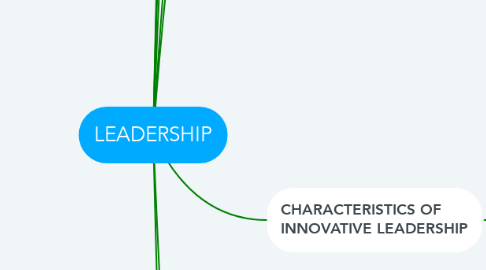
1. 5.1 Leadership is the ability to influence a group toward the achievement of goals. Leaders establish direction by developing a vision of the future and inspiring them to overcome hurdles.
2. It begins with the idea that there are specific virtues a leader must have. These are usually inborn traits, manifesting themselves in the “born leader” that cannot help but take control and guide situations.
2.1. This theory considers personality, social, physical, or intellectual traits to differentiate leaders from non-leaders. (Leaders are born to be leaders)
3. 7 TRAITS OF A GOOD LEADER
3.1. Ambition And Energy
3.1.1. The Desire To Lead
3.2. Honest And Integrity
3.3. Self-Confidence
3.4. Intelligence
3.5. High Self-Monitoring
3.6. Job-Relevant Knowledge
4. THE BIG FIVE PERSONALITY
4.1. Openness
4.2. Conscientiousness
4.3. Extraversion
4.4. Agreeableness
4.5. Neuroticism
4.6. Openness
4.6.1. People who are high in this trait tend to be more adventurous and creative. People low in this trait are often much more traditional and may struggle with abstract thinking.
4.7. Conscientiousness
4.7.1. Standard features of this dimension include high levels of thoughtfulness, good impulse control, and goal-directed behaviors.1 Highly conscientious people tend to be organized and mindful of details. They plan ahead, think about how their behavior affects others, and are mindful of deadlines.
4.8. Extraversion
4.8.1. characterized by excitability, sociability, talkativeness, assertiveness, and high amounts of emotional expressiveness.1 People who are high in extraversion are outgoing and tend to gain energy in social situations. Being around other people helps them feel energized and excited.
4.9. Agreeableness
4.9.1. trust, altruism, kindness, affection, and other pro-social behaviors.1 People who are high in agreeableness tend to be more cooperative while those low in this trait tend to be more competitive and sometimes even manipulative.
4.10. Neuroticism
4.10.1. sadness, moodiness, and emotional instability.1 Individuals who are high in this trait tend to experience mood swings, anxiety, irritability, and sadness. Those low in this trait tend to be more stable and emotionally resilient.
5. 5.2 INNOVATIVE LEADERSHIP
5.1. Leadership is the ability to get followers deeply committed to fulfilling a vision, objective, or course of action that they believe is achievable and worthwhile.
5.2. Innovative leader, though, is an exceptional and rare one; a person who promotes and focuses maximum effective creativity from followers to achieve remarkable breakthroughs in the organization.
6. CHARACTERISTICS OF INNOVATIVE LEADERSHIP
6.1. FAST AND ACTION ORIENTED
6.2. Innovative leader are speedy, responsiveness and agility in analyzing situations, make decisions and act on opportunities.
6.3. IMMERSED IN PROGRESSIVE CHANGE
6.4. Innovative leader fosters a culture of on-going, never ending change.
6.5. FUTURE-OBSESSED
6.6. Innovative leader visualizes his/her organization’s future and plot its course.
6.7. MASTERS OF MOTIVATION AND INSPIRATION
6.8. Innovative leader makes people feel good about themselves and they make them feel good about what they’re accomplishing
6.9. PASSIONATE
6.10. Innovative leader freely expresses emotions, and showcase their excitement about new ideas and change.
6.11. SUPER-SALESPEOPLE AND EVANGELISTS
6.12. Innovative leader persuasively communicates an optimistic, bright, enticing picture or the future for their followers.
6.13. RULE BREAKERS
6.14. Innovative leader creates common sense, flexible, and ethical guidelines to creatively operate.
6.15. MOUNTAIN CLIMBERS
6.16. Innovative leader creates on-going inspiring short-term visions and galvanizing followers to rush toward them.
6.17. OPPORTUNISTS
6.18. Innovative leader seeks out and grab ideas and opportunities before other are even aware of their existence.
6.19. BUILDERS
6.20. Innovative leader creates an environment where imagination, smart risk-taking, aggressive initiatives, and bold tactics are encouraged and rewarded.
6.21. HIGH-GAIN RISK-TAKERS
6.22. Innovative leader seeks large gains and aren’t afraid to take smart calculated risks.
7. 5.3 ORGANIZATIONAL STRUCTURE AND SUPPORT
7.1. to be continually addressed by organizations. They should be viewed as issues that need to be managed rather than problems that can be solved.
7.1.1. 1. Growth orientation
7.1.1.1. Commitment to L-T growth rather than S-T profit (objective is to grow the business)
7.1.2. 2. Vigilance
7.1.2.1. The ability of the organization to be aware of its threats and opportunities (continual attentiveness; requires external scanning by senior management and all members of the organization)
7.1.3. 3.Commitment to technology
7.1.3.1. The willingness to invest in the L-T development of technology. (a commitment to resources in terms of intellectual input from science, technology and engineering)
7.1.4. 4. Acceptance to risks
7.1.4.1. The willingness to include risky opportunities in a balanced portfolio (the willingness to consider carefully risky opportunities)
7.1.5. 5. Cross-functional cooperation
7.1.5.1. Mutual respect among individuals and a willingness to work together across functions. (The ability to confront and resolve frustration and conflict among functional departments. For example, between Marketing and R & D.
7.1.6. 6. Receptivity
7.1.6.1. The ability to be aware of, to identify and to take effective advantage of externally develop technology (Joint Venture / alliances)
7.1.7. 7. ‘Slack’
7.1.7.1. An ability to manage the innovation dilemma and provide room for creativity (allow individual room to think, experiment, discuss ideas and be creative)
7.1.8. 8. Adaptability
7.1.8.1. A readiness to accept change (the organization must be ready to accept change in the way it manages its internal activities, and need the ability to the changing environment)
7.1.9. 9. Diverse range of skills .
7.1.9.1. A combination of specialization, and diversity of knowledge and skills in the form of expert.
8. 5.4 BARRIERS TO ORGANIZATIONAL CREATIVITY AND INNOVATION
8.1. BARRIERS TO ORGANIZATIONAL CREATIVITY AND INNOVATION
8.1.1. Lack of Organizational Slack
8.1.2. Bureaucracy
8.1.3. Structure
8.1.4. Poor Communication
8.1.5. The ‘Imported Talent’ Syndrome
8.1.6. Financial
8.1.7. Aversion to Risk Taking
